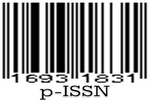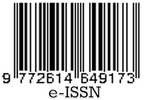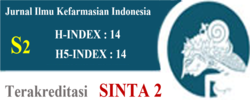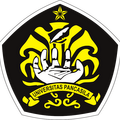Activity of Antibiotic Bacterial Isolate Kp13 and Cell Leakage Analysis of Escherichia coli Bacteria
Abstract
A bacterium is one of microorganisms that can produce secondary metabolite, such as antibiotic. KP13 isolate is a bacterium isolated from Melaleucaleuca dendron L rhizosphere. The aim of this study is to know the eff ect of the most active fraction antibacterium of KP13 isolate toward Escherichia coli bacterium and the ability to caused cell leakage. Extraction of antibiotic was conducted by ethyl acetate. Extract is fractioned with a n-heksan-etilacetate solvent gradient another uses a solvent methanol. Each fraction is done by KLT and grouped based on RF value. A fraction group is compare by inhibition eff ectiveness. Then, the Minimum Inhibitory Concentration (MIC) from the most active group is tested. Cell leakage analysis was performed using UV spectrophotometry to detect the release of nucleic acid and protein. Atomic Absorption Spectrophotometry (AAS) was used to detect ion release of K+ and Ca2+ from. cell of bacteria. The results showed that the most active fraction against Escherichia coli was the fraction number 1 with MIC value of 5% and inhibition zone of 7.33±0.58 mm.
References
2. Azrifitria, A.S., Chairul. Aktivitas antibakteri ekstrak etanolik daun dan umbi Crinum asiaticum L. terhadap bakteri penyebab jerawat. Majalah Farmasi Indonesia. 2010. 21.
3. Brooks, G. F., Butel, J. S., Morse, S. A. Jawetz, Melnick, Adelberg, Mikrobiologi Kedokteran. Edisi 23.diterjemahkan Hartanto, H., Penerbit Buku Kedokteran EGC, Jakarta.2007.
4. Chudlori, B., Kuswandi, M., Indrayudha. Pola Kuman dan Resistensinya Terhadap Antibiotika dari Spesimen PUS di RSUD Dr. Moewardi Tahun 2012. Pharmacon. 2012. 13(2): 70-76.
5. Cox, S. D., Mann, C. M., Markham, J. L., Gustafson, J. E., Warmington, J. R. dan Wyllie, S. G. Determining the Antimicrobial Actions of Tea Tree Oil. Molecules.2001. 6: 87-91.
6. Devereux, R. dan Wilkinson S.S. Amplification of Ribosomal RNA Sequences, Kluwer Academic Publisher, Netherlands.2004.
7. Dwisari D., Dharma S., dan Al Khaira N. Q. Perbandingan Pengaruh Pemberian Ekstrak Etanol Defatting dan Ekstrak Etanol Daun Benalu Kopi Scurrula ferruginea (Jack) Danser terhadap Kadar Glukosa Darah Mencit Putih Jantan. SCIENTIA. 2015. 5(2):2087-5045.
8. Hemashenpagam, N. Purification of Secondary Metabolites from Soil Actinomycetes. International Journal of Microbiology Research. 2011 3: 148-156.
9. Katavic, P.L. Chemical Investigation of the Alkaloids from the plants of the family Elaeocarpaceae. Natural Product Discovery (NPD). Faculty of Science, Griffith University. Australia.2005.
10. Kusumaningtyas, E., Astuti, E., dan Darmono. Sensitivitas Metode Bioautografi Kontak dan Agar Overlay dalam Penentuan Senyawa Antikapang. Jurnal Ilmu Kefarmasian Indonesia.2008. 6(2): 75-79.
11. Madigan M.T., Martinko J. M., dan Parker. J. Brook Biology of Microorganisms, 10th ed, Prentice-Hall Inc., New Jersey.2003.
12. Mardiastuti, H.W., Karuniawati, A., Kiranasari, A., Ikaningsih., dan Kadarsih, R. Emerging Resistance Pathogen: Situasi Terkini di Asia, Eropa, Amerika Serikat, Timur Tengah, dan Indonesia, Majalah Kedokteran Indonesia. 2007. 57(3).
13. McMurry, J.; dan Fay, R.C.McMurry Fay Chemistry, Edisi Keempat, C.A : Pearson Education International, Belmont.2004.
14. Nikaido.H., dan Vaara. M. Molecular Basis of Bacterial Outer Membrane Permeability, Microb Reviews. 1985. 49(1):1-32.
15. Pandey, A., Ali, I., Butola, K.S., Chatterji, T., Singh, V. Isolation and Characterization of Actinomycetes from Soil and Evaluation of Antibacterial Activities of Actinomycetes Against Pathogens, International Journal of Applied Biology and Pharmaceutical Technology.2011. 2(4)
16. Park S.J., Park H.W., dan Park. J. Inactivation Kinetics of Food Poisoning Microorganisms by Carbon Dioxide and High Hydrostatic Pressure. J. FoodSci. 2003. 68(3):976-981.
17. Pratiwi, S.T. Mikrobiologi Farmasi, Fakultas Farmasi UGM, Penerbit Erlangga, Yogyakarta.2008.
18. Rahayu, T.Potensi Antibiotik Isolat Bakteri Rizosfer Terhadap Bakteri Escherichia Coli Multiresisten, Jurnal Penelitian Sains & Teknologi, 2006. 7(2): 81 – 91
19. Rante, H. Purification and characterization of anti-multidrug resistances bacteria from actinomycetes associated sponge. Indonesian Journal of Pharmacy. 2010. 21(3).
20. Rao,N. S. S.Mikrobiologi Tanah dan Pertumbuhan Tanaman, diterjemahkan oleh Susilo, H. UI Press, Jakarta.1994.63: 38-39
21. Salni, Marisa. H., dan Mukti, R.W. Isolasi Senyawa Antibakteri Dari Daun Jengkol (Pithecolobium lobatum Benth) dan Penentuan Nilai KHM-nya.Jurnal Penelitian Sains.2011. 14(1): 14109.
22. Singh, L., Sharma, H., Talukdar, N.C. Production of Potent Antimicrobial Agent by Actinomycetes, Streptomyces sannanensis Strain SU118 Isolated from Phoomdi in Loktak Lake of Manipur, India, BMC Microbiology.2014. 14(278).
23. Suliantari.Aktivitas Antibakteri dan Mekanisme Penghambatan Ekstrak Sirih Hijau (Piper betle Linn) terhadap Bakteri Patogen Pangan, Disertasi, Jurusan Ilmu Pangan, Sekolah Pascasarjana, IPB, Bogor.2009.
24. Sulistyani, N. and Mulyadi. Aktivitas Cairan Kultur 12 Isolat ActinomycetesTerhadap Bakteri Resisten,KESMAS. 2013.Vol.7(2): 55-112.
25. Tanaya V., Retnowati R., dan Suratmo. Fraksi Semi Polar dari Daun Mangga Kasturi (Mangifera casturi Kosterm), Kimia Student Journal.2015. 1(1):778–784.
26. Ultee. A., Goris. L. G. M., dan Smidt. E. J. Bacterial Activity of Carvacrol Towards the Feed-borne Pathogen Bacillus Cereis, J. App. Microbiol.1998. 85:213-218.
27. Wang, X., Huang, L., Kang, Z., Buchenauer, H., andGao, X.,Optimization of the Fermentation Process of Actinomycete Strain Hhs.015T.Journal of Biomedicine and Biotechnology.2010. Article ID 141876, 10 pages.
28. Zhao, J. Yang, N, and Zeng, R. Phylogenetic analysis of type I polyketide synthase and nonribosomal peptide synthetase genes in antartic sediment. J. Extremophilles.2008. 19: 97-105.
Licencing
All articles in Jurnal Ilmu Kefarmasian Indonesia are an open-access article, distributed under the terms of the Creative Commons Attribution-NonCommercial-ShareAlike 4.0 International License which permits unrestricted non-commercial used, distribution and reproduction in any medium.
This licence applies to Author(s) and Public Reader means that the users mays :
- SHARE:
copy and redistribute the article in any medium or format - ADAPT:
remix, transform, and build upon the article (eg.: to produce a new research work and, possibly, a new publication) - ALIKE:
If you remix, transform, or build upon the article, you must distribute your contributions under the same license as the original. - NO ADDITIONAL RESTRICTIONS:
You may not apply legal terms or technological measures that legally restrict others from doing anything the license permits.
It does however mean that when you use it you must:
- ATTRIBUTION: You must give appropriate credit to both the Author(s) and the journal, provide a link to the license, and indicate if changes were made. You may do so in any reasonable manner, but not in any way that suggests the licensor endorses you or your use.
You may not:
- NONCOMMERCIAL: You may not use the article for commercial purposes.
This work is licensed under a Creative Commons Attribution-NonCommercial-ShareAlike 4.0 International License.





 Tools
Tools





















